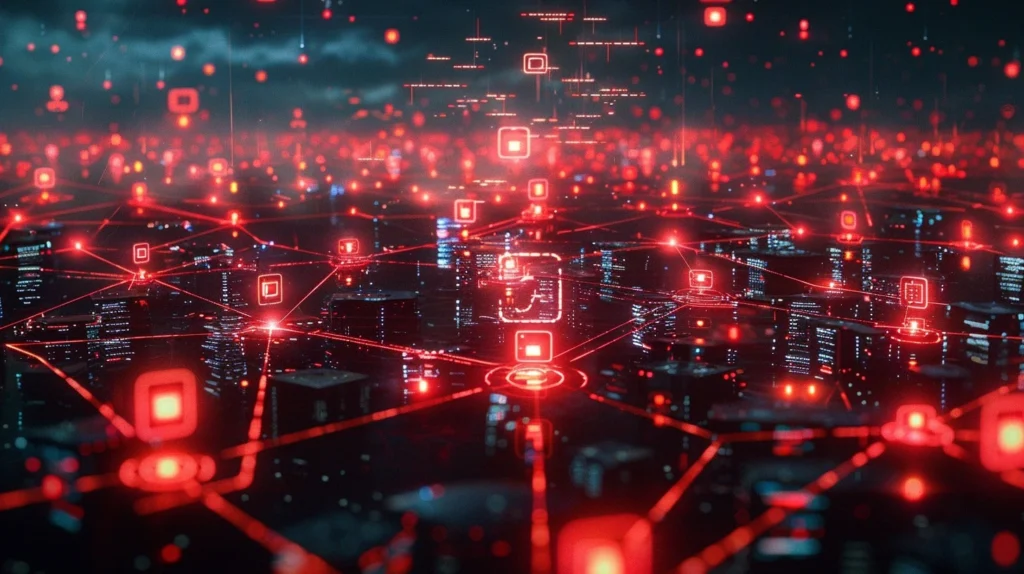
The 5G Revolution is not just another leap in technology; it’s a monumental shift that is reshaping how we live, work, and interact with the world around us. As the latest generation of mobile networks, 5G is delivering ultra-fast connectivity, low latency, and unprecedented bandwidth. This revolution is unlocking new possibilities in industries ranging from healthcare and entertainment to transportation and manufacturing. In this article, we will explore how the 5G Revolution is transforming our lives and why it is such a game-changer for modern society.

1. Unprecedented Speed and Connectivity
In the age of digital transformation, unprecedented speed and connectivity are redefining how we live, work, and interact. The advent of technologies like 5G, fiber optics, and enhanced broadband has unlocked faster data transfer rates, minimal latency, and seamless global communication. This transformation is setting the stage for innovations across industries, from entertainment and healthcare to business and education. In this article, we will explore how this technological leap is reshaping various sectors and the broader implications for society.
1. Accelerating Digital Experiences
The rise of unprecedented speed and connectivity has completely revolutionized digital experiences. With faster internet speeds, users can download movies in seconds, stream ultra-high-definition videos without buffering, and enjoy lag-free online gaming. Beyond personal use, this enhanced connectivity is transforming industries such as media, where content creators can produce and distribute richer, more immersive experiences through virtual and augmented reality.
For businesses, this speed enables real-time collaboration on a global scale, improving productivity and enabling remote work. Video conferencing, file sharing, and cloud services run seamlessly, allowing teams to work across different time zones without interruptions.
2. The Backbone of the Internet of Things (IoT)
Unprecedented speed and connectivity are the driving forces behind the expansion of the Internet of Things (IoT). With faster data transmission and lower latency, millions of connected devices—from smart home systems to industrial sensors—can communicate with each other in real-time. This interconnected ecosystem is making homes, cities, and industries smarter and more efficient.
In industries like manufacturing and logistics, IoT devices powered by fast, reliable networks enable real-time monitoring and predictive maintenance, reducing downtime and optimizing production. Meanwhile, smart cities are using these advancements to manage energy consumption, reduce traffic congestion, and enhance public safety through connected infrastructure.
3. Transforming Healthcare Delivery
The healthcare industry is witnessing a significant transformation thanks to unprecedented speed and connectivity. Telemedicine, for example, is rapidly expanding as fast internet speeds enable real-time consultations between doctors and patients. This is particularly valuable in rural or underserved areas, where access to healthcare services is limited.
Moreover, advancements in connectivity allow for the seamless sharing of large medical files such as MRI scans or genomic data, improving diagnostic accuracy and speeding up treatment. Wearable health devices and remote patient monitoring are becoming more common, allowing healthcare providers to track vital signs and intervene promptly when necessary.
4. Fueling the Next Generation of Business and Innovation
For businesses, unprecedented speed and connectivity are opening up new avenues for innovation. Fast internet is essential for cloud computing, artificial intelligence (AI), and big data analytics, all of which are critical to staying competitive in the digital economy. Companies can now process massive datasets in real-time, make informed decisions faster, and deliver more personalized customer experiences.
Additionally, ultra-fast connectivity supports the development of advanced AI applications such as real-time language translation, autonomous systems, and intelligent automation, which are reshaping industries from retail to finance. Businesses are using these technologies to create more efficient operations, drive innovation, and respond to customer needs more quickly than ever before.
5. Empowering Remote Work and Education
The global shift towards remote work and online education has been significantly empowered by unprecedented speed and connectivity. High-speed internet has become a necessity for virtual collaboration, allowing employees to work from anywhere without sacrificing efficiency. Platforms like Zoom, Microsoft Teams, and Google Meet rely on fast connections to support seamless video conferencing and project management.
Similarly, in education, students can now participate in virtual classrooms, access interactive learning materials, and collaborate with peers in real-time. Faster internet speeds are making online learning more interactive and accessible, helping to bridge the digital divide by ensuring students in remote areas have access to high-quality educational content.
6. Revolutionizing Entertainment and Media
The entertainment industry has undergone a dramatic transformation with the rise of unprecedented speed and connectivity. Streaming platforms like Netflix, Amazon Prime, and Disney+ now deliver 4K and even 8K content without buffering, providing a more immersive viewing experience. Additionally, faster internet speeds are enabling new forms of interactive entertainment, including cloud gaming, where users can play high-quality video games without the need for expensive hardware.
In music, film, and media production, the ability to transfer large files quickly allows for more efficient collaboration between creators around the world. Artists and content creators can now work on complex projects in real-time, regardless of their physical location.
7. Challenges of Increased Connectivity
While the benefits of unprecedented speed and connectivity are clear, they also come with challenges. The increase in connected devices raises concerns about cybersecurity, as more data is transmitted across networks. Protecting sensitive information from cyber threats becomes even more critical as businesses and individuals rely more on digital systems.
Additionally, the rapid pace of technological advancement can widen the digital divide, particularly in regions where high-speed internet infrastructure is still lacking. Ensuring equitable access to these technologies will be key to maximizing their global impact.
Unprecedented speed and connectivity are reshaping the way we live and work, enabling new innovations and transforming industries. From healthcare and education to business and entertainment, the ability to connect quickly and reliably is unlocking possibilities that were unimaginable just a decade ago. As we move further into the digital age, this enhanced connectivity will continue to drive progress, bringing us closer to a future where technology empowers every aspect of our lives.

2. The Internet of Things (IoT) Explosion
The Internet of Things (IoT) has rapidly emerged as one of the most transformative technologies of the 21st century. From smart homes to industrial automation, the IoT explosion is connecting billions of devices, reshaping industries, and changing how we interact with the world around us. In this article, we explore the rise of IoT, its applications, challenges, and its profound impact on businesses, industries, and everyday life.
1. What is the Internet of Things (IoT)?
The Internet of Things (IoT) refers to the network of interconnected physical devices that communicate and exchange data with each other through the internet. These devices, often embedded with sensors, software, and connectivity features, range from simple household items like thermostats and lights to complex industrial machinery. The data generated by IoT devices is analyzed to provide insights, automate tasks, and improve efficiency across various sectors.
2. The IoT Explosion: Numbers and Growth
The growth of IoT has been nothing short of explosive. According to Statista, there were more than 10 billion IoT-connected devices in 2021, with projections indicating that this number will grow to over 25 billion by 2030. The increasing affordability of sensors, improved connectivity, and advancements in cloud computing have fueled this expansion. With IoT devices becoming more affordable and accessible, the integration of smart technology into daily life and business operations is becoming increasingly seamless.
3. IoT in Everyday Life
One of the most visible impacts of the IoT explosion is in the consumer space. Smart home devices like Amazon Alexa, Google Nest, and smart refrigerators have become commonplace. These devices provide convenience, security, and energy efficiency by automating tasks and responding to user commands.
- Smart homes: From controlling lighting and temperature to securing homes through connected cameras and doorbells, IoT has redefined modern living.
- Wearables: Devices like fitness trackers and smartwatches monitor health, track fitness goals, and even alert users to potential health risks, making personal health management more proactive.
4. Industrial IoT: The Future of Manufacturing and Logistics
The rise of IoT is also revolutionizing industries. In manufacturing, logistics, and agriculture, IoT has become a critical component in optimizing processes, improving productivity, and enhancing decision-making.
- Smart factories: The industrial IoT (IIoT) is transforming manufacturing through predictive maintenance, real-time monitoring, and automation. Machines connected via IoT sensors can report on performance, identify issues before breakdowns occur, and reduce downtime, resulting in greater efficiency.
- Supply chain management: IoT in logistics enables companies to track shipments in real-time, monitor storage conditions (such as temperature for perishable goods), and optimize delivery routes to ensure timely deliveries.
- Precision agriculture: IoT is enabling farmers to use data to optimize planting, irrigation, and harvesting, leading to more efficient and sustainable farming practices. IoT devices in agriculture can monitor soil conditions, crop health, and weather patterns, providing data-driven insights that lead to better decision-making.
5. Healthcare and IoT: A Revolution in Patient Care
In healthcare, IoT is transforming how medical care is delivered. Wearable devices, smart medical equipment, and remote monitoring solutions are providing patients with more personalized and timely care.
- Remote patient monitoring: IoT enables continuous monitoring of patients’ vital signs and health metrics, allowing doctors to provide real-time care without the need for in-person visits. This is particularly beneficial for patients with chronic conditions who require constant monitoring.
- Smart medical devices: Devices like connected glucose monitors and smart inhalers help patients manage their conditions more effectively by providing real-time feedback and reminders to take medication.
6. Smart Cities: IoT’s Impact on Urban Development
As urbanization continues to grow, IoT is playing a crucial role in the development of smart cities. These cities use connected technologies to improve the efficiency of urban services, reduce energy consumption, and enhance the quality of life for residents.
- Traffic management: IoT-enabled sensors monitor traffic flow in real-time, allowing cities to adjust traffic lights, provide alternate routes, and reduce congestion.
- Energy efficiency: Smart grids and IoT-enabled buildings optimize energy use by automatically adjusting heating, cooling, and lighting systems based on occupancy and environmental factors.
7. Challenges of the IoT Explosion
While the IoT explosion presents immense opportunities, it also comes with significant challenges.
- Security: The more devices that are connected to the internet, the more entry points exist for cyber-attacks. IoT devices often have limited processing power, which can make them vulnerable to hacking.
- Data privacy: With billions of devices collecting vast amounts of personal and sensitive data, ensuring data privacy is a growing concern. Companies must implement robust data protection measures to safeguard users’ information.
- Interoperability: With so many different IoT devices and platforms available, ensuring they can communicate and work together seamlessly is a major challenge. Standardization across the IoT ecosystem is critical to unlocking the full potential of connected devices.
8. The Future of IoT: What’s Next?
The IoT explosion is far from over. As technology advances and 5G connectivity becomes more widespread, the capabilities of IoT devices will continue to grow.
- AI and machine learning: Combining IoT with artificial intelligence will enable even more advanced applications. Smart devices will not only collect data but will also analyze it in real-time, enabling more accurate predictions and faster decision-making.
- Edge computing: As IoT devices generate vast amounts of data, edge computing, which processes data closer to where it is generated, will become essential. This will reduce latency and allow for faster, more efficient data processing.
- Sustainability: IoT has the potential to play a significant role in addressing global challenges like climate change. Smart grids, connected environmental sensors, and precision agriculture can help reduce resource consumption and mitigate environmental impact.
The IoT explosion is transforming industries, enhancing everyday life, and shaping the future of technology. As billions of devices come online, businesses and individuals will continue to benefit from enhanced connectivity, efficiency, and automation. However, addressing the challenges of security, data privacy, and interoperability will be crucial to ensuring that the IoT revolution realizes its full potential. As we move into the next phase of this technological evolution, the possibilities for innovation are limitless, and the impact of IoT on our world will only continue to grow.
3. Transforming Industries with 5G
The advent of 5G technology is revolutionizing industries across the globe. With its unprecedented speed, low latency, and massive connectivity potential, 5G is poised to redefine how businesses operate, how services are delivered, and how people interact with technology. From healthcare and manufacturing to entertainment and transportation, the impact of 5G is both broad and profound. In this article, we explore how 5G is transforming various industries and shaping the future of innovation.
1. What Makes 5G Different?
Before diving into its transformative potential, it’s important to understand what sets 5G apart from previous generations of mobile networks. With data transfer rates up to 100 times faster than 4G, latency as low as one millisecond, and the ability to connect a massive number of devices simultaneously, 5G provides a platform for unprecedented connectivity and real-time interactions.
These advancements enable applications that were previously impossible or impractical with earlier generations of networks. For industries that rely on automation, data analysis, and connected systems, 5G opens up new possibilities for efficiency, innovation, and scalability.
2. 5G in Manufacturing: The Smart Factory Revolution
One of the industries that stands to gain the most from 5G is manufacturing. The shift towards smart factories or Industry 4.0, where machines, systems, and processes are interconnected and automated, relies heavily on fast, reliable communication networks.
- Real-time data and monitoring: With 5G, manufacturers can use sensors to collect data in real-time, enabling predictive maintenance, improved quality control, and efficient resource management. Machines can communicate with each other faster and make decisions autonomously, reducing downtime and increasing productivity.
- Automation and robotics: Advanced robotics powered by 5G will enable greater automation, allowing factories to operate 24/7 with minimal human intervention. Autonomous robots and drones can communicate with centralized systems, adapting to production needs in real-time.
- Augmented and virtual reality: 5G supports the use of augmented and virtual reality (AR/VR) technologies for training, design, and troubleshooting. Workers can access AR headsets for real-time instructions or to collaborate remotely, streamlining complex tasks.
3. Healthcare: Telemedicine and Beyond
In healthcare, 5G is a game-changer. The ability to transfer large amounts of data almost instantly, combined with low latency, enables breakthroughs in telemedicine, remote surgery, and real-time health monitoring.
- Telemedicine: During the COVID-19 pandemic, telemedicine became a vital tool for healthcare providers. With 5G, the quality of virtual consultations improves dramatically, with clearer video, faster data sharing, and enhanced diagnostic capabilities. Doctors can review patient data in real-time, making remote care more accessible and efficient.
- Remote surgery: The ultra-low latency of 5G enables remote surgeries, where surgeons can operate on patients from different parts of the world using robotic systems. This reduces the need for patients to travel for specialized care and opens up access to cutting-edge treatments.
- Wearable health devices: 5G allows for continuous real-time monitoring of patients through wearables that track vital signs like heart rate, glucose levels, and oxygen saturation. This enables proactive healthcare, where potential issues can be detected and addressed before they become serious.
4. Entertainment and Media: Redefining the Consumer Experience
The 5G revolution is also transforming the entertainment and media industry. With higher speeds and more reliable connections, consumers can enjoy better quality streaming, immersive gaming experiences, and augmented reality entertainment.
- Streaming and gaming: 5G enables seamless streaming of ultra-high-definition content and faster load times for gaming. The gaming industry, in particular, will benefit from 5G, as it allows for real-time multiplayer gaming with no lag, even for mobile devices.
- Augmented and virtual reality: The low latency and high bandwidth of 5G will enhance AR and VR experiences. Imagine watching live sports in AR or attending virtual concerts that feel incredibly lifelike. These experiences are made possible with 5G, creating new business models for content creators and entertainers.
5. Transportation: The Path to Autonomous Vehicles
The transportation sector is on the cusp of a major transformation, driven in part by 5G. Autonomous vehicles (AVs) require constant communication with the cloud, other vehicles, and surrounding infrastructure to operate safely and efficiently. 5G provides the network reliability and speed needed for real-time decision-making in autonomous driving.
- Vehicle-to-everything (V2X) communication: 5G enables V2X communication, where vehicles can communicate with other vehicles, infrastructure, and even pedestrians. This allows for safer driving, traffic management, and optimized routes, reducing congestion and improving overall transportation efficiency.
- Smart cities: In the context of smart cities, 5G will support intelligent traffic systems, connected public transportation, and optimized parking solutions. Sensors and IoT devices integrated into road infrastructure can collect data to monitor traffic patterns, adjust traffic lights, and create safer, more efficient urban environments.
6. Retail: The Future of Shopping
Retail is another industry undergoing a transformation thanks to 5G. With faster connectivity, retailers can offer more personalized shopping experiences, seamless mobile payments, and improved inventory management.
- Enhanced customer experiences: 5G allows retailers to use AR and VR for virtual try-ons, 3D product visualizations, and immersive shopping experiences. Customers can see how furniture would look in their homes or try on clothes virtually, creating a more interactive shopping environment.
- Supply chain and logistics: In retail, 5G improves visibility across the supply chain, enabling real-time inventory tracking, faster delivery times, and more efficient warehouse management. With IoT sensors and 5G connectivity, retailers can streamline operations and reduce costs.
7. Energy and Utilities: Smart Grids and Sustainability
The energy and utilities sectors are embracing 5G to build smart grids, monitor energy consumption, and support renewable energy sources. 5G enables the real-time analysis of energy usage, allowing for more efficient and sustainable energy distribution.
- Smart grids: 5G supports smart grids that can dynamically adjust energy flows based on real-time demand. This improves energy efficiency and enables the integration of renewable energy sources such as solar and wind power.
- Remote monitoring and maintenance: Utilities can use 5G to monitor infrastructure in real-time, enabling predictive maintenance and reducing the risk of outages. For example, IoT sensors connected via 5G can detect faults in power lines or pipelines, allowing for immediate action.
8. Challenges of Implementing 5G
Despite its transformative potential, the widespread adoption of 5G faces several challenges.
- Infrastructure: Building the infrastructure required for 5G is a massive undertaking. Deploying the small cells and antennas necessary for 5G coverage, particularly in rural or remote areas, presents logistical and financial challenges.
- Security: With increased connectivity comes heightened security risks. As industries adopt 5G for mission-critical operations, ensuring data security and protecting against cyber threats will be essential.
- Cost: The cost of upgrading to 5G technology can be prohibitive for some businesses, especially small and medium-sized enterprises. While the benefits of 5G are clear, companies will need to carefully weigh the costs and plan for a phased adoption.
The 5G revolution is transforming industries, unlocking new opportunities, and driving innovation across various sectors. From enabling smarter manufacturing processes and enhancing healthcare delivery to revolutionizing entertainment and paving the way for autonomous vehicles, 5G is reshaping the way we live, work, and interact with technology. As businesses and governments work to overcome the challenges of 5G deployment, the future holds immense potential for growth, efficiency, and creativity. The industries that embrace this technology will be at the forefront of the next era of digital transformation, leading us into a more connected and dynamic world.

4. Revolutionizing Healthcare
The 5G Revolution is having a profound impact on the healthcare sector. With 5G’s low latency and high-speed data transfers, telemedicine is becoming more viable, allowing doctors to remotely diagnose and treat patients. This is particularly crucial in rural or underserved areas where access to healthcare services is limited. The 5G Revolution enables real-time consultations, remote surgeries, and the use of AI-powered diagnostics.
Furthermore, 5G will enhance the use of wearables and connected health devices. Patients can be continuously monitored in real-time, providing healthcare providers with vital data to make informed decisions. The 5G Revolution will lead to personalized medicine and improved patient outcomes, as data-driven insights can be shared instantly between patients and healthcare professionals.
5. Entertainment and Immersive Experiences
The entertainment industry is already feeling the effects of the 5G Revolution. With 5G, streaming services can offer ultra-high-definition content without buffering, and gamers can enjoy lag-free multiplayer experiences. Beyond traditional entertainment, the 5G Revolution is unlocking new frontiers in immersive experiences such as virtual reality (VR) and augmented reality (AR).
5G’s low latency and high bandwidth allow for smoother VR and AR interactions, making these technologies more accessible for gaming, education, and training. Imagine being able to attend a concert or sporting event virtually, with a 360-degree view, as if you were there in person. The 5G Revolution is turning this into reality by enabling richer and more interactive experiences.
6. Enhancing Education and Remote Learning
Education is another sector benefiting from the 5G Revolution. The COVID-19 pandemic accelerated the adoption of remote learning, and 5G is now improving the quality of these experiences. With high-speed connectivity and low latency, students can participate in live, interactive virtual classrooms, access high-definition educational content, and collaborate with peers globally.
The 5G Revolution also enhances experiential learning through VR and AR. For instance, students can take virtual field trips to historical sites, explore the human body in 3D, or conduct science experiments in a virtual lab. These immersive experiences, powered by 5G, are making learning more engaging and accessible, breaking down geographical barriers to education.
7. 5G and the Future of Work
The 5G Revolution is reshaping the way we work, enabling new possibilities for remote and hybrid work models. With faster data speeds and more reliable connectivity, businesses can deploy advanced collaboration tools, video conferencing platforms, and cloud-based services without interruptions. This allows employees to work from virtually anywhere, enhancing productivity and work-life balance.
The 5G Revolution also supports the rise of AI-powered tools in the workplace, automating repetitive tasks and improving decision-making processes. By enabling seamless communication and access to real-time data, 5G is driving digital transformation across businesses of all sizes.
8. Challenges and Considerations
Despite its transformative potential, the 5G Revolution comes with challenges. The infrastructure required to support 5G networks is costly and requires significant investment. Additionally, concerns around data security, privacy, and cyberattacks are heightened as more devices are connected to the 5G network. Governments and businesses must work together to address these issues and ensure the safe and ethical deployment of 5G technology.
Moreover, the 5G Revolution will require a workforce that is equipped with the necessary skills to manage and operate these advanced technologies. Continuous education and training programs will be essential to preparing the workforce for the changes brought about by 5G.

Conclusion
The 5G Revolution is more than just a technological upgrade; it is a transformative force that is reshaping industries, improving connectivity, and opening up new possibilities for innovation. From ultra-fast data speeds and enhanced IoT capabilities to revolutionizing healthcare, entertainment, and education, the 5G Revolution is poised to have a lasting impact on our lives. As we continue to embrace this new era of connectivity, the world will experience unprecedented advancements in technology and communication, bringing us closer to a more connected, efficient, and innovative future.
by: clevermkt and clever marketing





